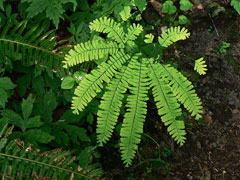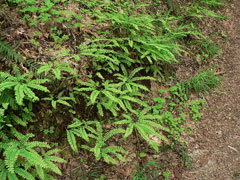 |
|
http://en.wikipedia.org/wiki/User_talk:Wsiegmund |
 |
| http://en.wikipedia.org/wiki/User_talk:Wsiegmund |
Translate this page:
Summary
Form: Irregular or sprawling.
Physical Characteristics

 Adiantum pedatum is a FERN growing to 0.5 m (1ft 8in) by 0.5 m (1ft 8in) at a slow rate.
Adiantum pedatum is a FERN growing to 0.5 m (1ft 8in) by 0.5 m (1ft 8in) at a slow rate.
See above for USDA hardiness. It is hardy to UK zone 3. The seeds ripen from August to October.
Suitable for: light (sandy), medium (loamy) and heavy (clay) soils and prefers well-drained soil. Suitable pH: mildly acid, neutral and basic (mildly alkaline) soils. It can grow in semi-shade (light woodland). It prefers moist soil.
UK Hardiness Map
US Hardiness Map
Synonyms
Plant Habitats
Woodland Garden Dappled Shade; Shady Edge; Ground Cover;
Edible Uses
References More on Edible Uses
Medicinal Uses
Plants For A Future can not take any responsibility for any adverse effects from the use of plants. Always seek advice from a professional before using a plant medicinally.
Antirheumatic Astringent Demulcent Emmenagogue Expectorant Febrifuge Haemostatic Pectoral
Tonic
The whole plant is considered to be antirheumatic, astringent, demulcent, emmenagogue, expectorant, febrifuge, haemostatic, pectoral and tonic[172, 222, 240]. A tea or syrup is used in the treatment of nasal congestion, asthma, sore throats etc[222]. A decoction of the root was massaged into rheumatic joints[257]. The N. American Indians chewed the fronds and then applied them to wounds to stop bleeding[213]. A strong infusion of the whole plant was has been used as an emetic in the treatment of ague and fevers[257]. This plant was highly valued as a medicinal plant in the 19th century and merits scientific investigation[222].
References More on Medicinal Uses
The Bookshop: Edible Plant Books
Our Latest books on Perennial Plants For Food Forests and Permaculture Gardens in paperback or digital formats.

Edible Tropical Plants
Food Forest Plants for Hotter Conditions: 250+ Plants For Tropical Food Forests & Permaculture Gardens.
More

Edible Temperate Plants
Plants for Your Food Forest: 500 Plants for Temperate Food Forests & Permaculture Gardens.
More

More Books
PFAF have eight books available in paperback and digital formats. Browse the shop for more information.
Shop Now
Other Uses
Basketry Hair Lining
The stipe of the plant is used as an ornament in basketry[172, 157]. The leaves can be used as a lining for carrying or storing fruits in baskets and on racks[257]. The plant is used as a hair conditioner[172]. The stems have been used as a hair wash to make the hair shiny[222]. Plants can be used for ground cover when planted about 30cm apart either way, they form a slowly spreading clump[208].
Special Uses
Food Forest Ground cover
References More on Other Uses
Cultivation details
Landscape Uses:Container, Foundation, Ground cover, Massing, Rock garden, Woodland garden. Easily grown in a cool moist shady position[1, 187]. Requires an abundance of moisture in the air and soil[1]. Prefers an alkaline soil[200]. Requires an acid soil according to another report. A very ornamental plant[1], it does not always succeed outdoors in Britain[1]. It probably prefers to be covered in snow overwinter - could a mulch help[1]? This species is often divided into three separate species by botanists - the type species is found in eastern N. America, A. aleuticum is found in western N. America and a third species is found in eastern Asia[270]. Members of this genus are rarely if ever troubled by browsing deer[233]. Plants have a slowly-increasing rootstock[233]. Special Features:Attractive foliage, North American native, Naturalizing, Wetlands plant, There are no flowers or blooms. The plant is heat tolerant in zones 8 through 1. (Plant Hardiness Zones show how well plants withstand cold winter temperatures.
Plant Heat Zones show when plants would start suffering from the heat.
The Plant Heat Zone map is based on the number of "heat days" experienced in a given area where the temperature climbs to over 86 degrees F (30°C).
At this temperature, many plants begin to suffer physiological damage. Heat Zones range from 1 (no heat days) to 12 (210 or more heat days).
For example Heat Zone. 11-1 indicates that the plant is heat tolerant in zones 11 through 1.) For polyculture design as well as the above-ground architecture (form - tree, shrub etc. and size shown above) information on the habit and root pattern is also useful and given here if available. The plant growth habit is a clumper with limited spread [1-2]. The root pattern is rhizomatous with underground stems sending roots and shoots along their length [1-2].
References Carbon Farming Information and Carbon Sequestration Information
Temperature Converter
Type a value in the Celsius field to convert the value to Fahrenheit:
Fahrenheit:
The PFAF Bookshop
Plants For A Future have a number of books available in paperback and digital form. Book titles include Edible Plants, Edible Perennials, Edible Trees,Edible Shrubs, Woodland Gardening, and Temperate Food Forest Plants. Our new book is Food Forest Plants For Hotter Conditions (Tropical and Sub-Tropical).
Shop Now
Plant Propagation
Spores - best sown as soon as ripe on the surface of a humus-rich sterilized soil. Keep the compost moist, preferably by putting a plastic bag over the pot. Pot on small clumps of plantlets as soon as they are large enough to handle and keep them humid until they are well established. Do not plant outside until the ferns are at least 2 years old and then only in a very well sheltered position. Division in spring or autumn.
Other Names
If available other names are mentioned here
Native Range
NORTHERN AMERICA: United States, Alaska, Connecticut, Indiana, Maine, New Hampshire, New Jersey, Ohio, Pennsylvania, Rhode Island, Vermont, West Virginia, Illinois, Iowa, Kansas, Minnesota, Missouri, Nebraska, Oklahoma, Wisconsin, Arkansas, Delaware, Georgia, Kentucky, Louisiana, Maryland, Mississippi, North Carolina, South Carolina, Tennessee, Virginia, District of Columbia, Canada, Québec, Nova Scotia, Ontario, New Brunswick.
Weed Potential
Right plant wrong place. We are currently updating this section.
Please note that a plant may be invasive in one area but may not in your area so it's worth checking.
Conservation Status
IUCN Red List of Threatened Plants Status :

Growth: S = slow M = medium F = fast. Soil: L = light (sandy) M = medium H = heavy (clay). pH: A = acid N = neutral B = basic (alkaline). Shade: F = full shade S = semi-shade N = no shade. Moisture: D = dry M = Moist We = wet Wa = water.
Now available:
Food Forest Plants for Mediterranean Conditions
350+ Perennial Plants For Mediterranean and Drier Food Forests and Permaculture Gardens.
[Paperback and eBook]
This is the third in Plants For A Future's series of plant guides for food forests tailored to
specific climate zones. Following volumes on temperate and tropical ecosystems, this book focuses
on species suited to Mediterranean conditions—regions with hot, dry summers and cool, wet winters,
often facing the added challenge of climate change.
Read More
Expert comment
Author
L.
Botanical References
200235270
Links / References
For a list of references used on this page please go here
Readers comment
| Add a comment |
|
If you have important information about this plant that may help other users please add a comment or link below. Only comments or links that are felt to be directly relevant to a plant will be included. If you think a comment/link or information contained on this page is inaccurate or misleading we would welcome your feedback at [email protected]. If you have questions about a plant please use the Forum on this website as we do not have the resources to answer questions ourselves.
* Please note: the comments by website users are not necessarily those held by PFAF and may give misleading or inaccurate information.
To leave a comment please Register or login here All comments need to be approved so will not appear immediately.
|
Subject : Adiantum pedatum
|
|
|
|